Fire Regions of a Northern Amazonian Landscape Relative to Indigenous Peoples’ Lands
Abstract
Highlights
- There is a strong connection between indigenous peoples’ livelihood practices and fires.
- Fire distribution patterns allowed for four distinct regions to emerge for Guyana, with the Coastal region hosting the most fires, while the Forest region had the fewest.
- Fires within the tropical landscapes influenced by indigenous people’s livelihood activities are an important element in maintaining tropical forest cover and diversity.
- The fire regions uncovered in our work may serve as the basis for examining the size, impacts, and ignition sources of fires rather than ecosystems.
Abstract
1. Introduction
2. Materials and Methods
2.1. Study Area and Its Fire Sources
2.2. Data Description
2.2.1. Fires
2.2.2. Indigenous Peoples’ Lands Location
2.3. Using Spatial and Temporal Distribution of Fires Relative to Indigenous Lands to Create Regions
3. Results
3.1. Fire Regions
3.2. Distribution of Fires Within Regions Relative to Indigenous Lands
3.3. Fires in Relation to Time of Year
4. Discussion and Conclusions
Author Contributions
Funding
Data Availability Statement
Acknowledgments
Conflicts of Interest
References
- Bowman, D.; Balch, J.K.; Artaxo, P.; Bond, W.J.; Carlson, J.M.; Cochrane, M.A.; Antonio, C.M.; DeFries, S.; Doyle, J.C.; Harrison, S.P.; et al. Fire in the Earth System. Science 2009, 324, 481–484. [Google Scholar] [CrossRef] [PubMed]
- Carmenta, R.; Parry, L.; Blackburn, A.; Vermeylen, S.; Barlow, J. Understanding Human-Fire Interactions in Tropical Forest Regions: A Case for Interdisciplinary Research across the Natural and Social Sciences. Ecol. Soc. 2011, 16, 53. [Google Scholar] [CrossRef]
- Aragão, L.; Malhi, Y.; Barbier, N.; Lima, A.; Shimabukuro, Y.; Anderson, L.; Saatchi, S. Interactions between Rainfall, Deforestation and Fires during Recent Years in the Brazilian Amazonia. Philos. Trans. R. Soc. Biol. Sci. 2008, 363, 1779–1785. [Google Scholar] [CrossRef] [PubMed]
- Eva, H.; Lambin, E. Fires and Land-Cover Change in the Tropics: A Remote Sensing Analysis at the Landscape Scale. J. Biogeogr. 2000, 27, 765–776. [Google Scholar] [CrossRef]
- Malingreau, J.; Tucker, C. Largescale Deforestation in the Southeastern Amazon Basin of Brazil. Ambio 1988, 17, 49–55. [Google Scholar]
- Pyne, S.J. Fire: A Brief History; University of Washington Press: Seattle, WA, USA, 2001. [Google Scholar]
- Kull, C.; Laris, P. Fire Ecology and Fire Politics in Mali and Madagascar. In Tropical Fire Ecology: Climate Change, Land Use and Ecosystem Dynamics; Cochrane, M.A., Ed.; Springer-Praxis Books in Environmental Series; Springer: Chichester, UK, 2009. [Google Scholar]
- Brady, N.C. Alternatives to Slash-and-Burn: A Global Imperative. Agric. Ecosyst. Environ. 1996, 58, 3–11. [Google Scholar] [CrossRef]
- Borchers, J.; Perry, D. Effects of Prescribed Fire on Soil Organisms. In Natural and Prescribed Fire in Pacific Northwest Forests; Walstad, J.D., Radosevich, S.R., Sandberg, D.V., Eds.; Oregon State University Press: Corvallis, OR, USA, 1990; pp. 143–158. [Google Scholar]
- Choromanska, U.; DeLuca, T. Microbial Activity and Nitrogen Mineralization in Forest Mineral Soils Following Heating: Evaluation of Post-Fire Effects. Soil Biol. Biochem. 2002, 34, 263–271. [Google Scholar] [CrossRef]
- Poth, M.; Anderson, I.C.; Miranda, H.S.; Miranda, A.C.; Riggan, P.J. The Magnitude and Persistence of Soil NO, N2O, CH4, and CO2 Fluxes from Burned Tropical Savanna in Brazil. Glob. Biochem. Cycles 1995, 9, 503–513. [Google Scholar] [CrossRef]
- Wan, S.; Hui, D.; Luo, Y. Fire Effects on Nitrogen Pools and Dynamics in Terrestrial Ecosystems: A Meta-Analysis. Ecol. Appl. 2001, 11, 1349–1365. [Google Scholar] [CrossRef]
- Lyon, L.; Stickney, P. Early Vegetal Succession Following Large Northern Rocky Mountain Wildfires. In Proceedings of the Montana Tall Timbers Fire Ecology Conference and Fire and Land Management Symposium, Tall Timbers Research Station, Missoula, MT, USA, 8–10 October 1976. [Google Scholar]
- Perez, B.; Moreno, J. Methods for Quantifying Fire Severity in Shrubland-Fires. Plant Ecol. 1998, 139, 91–101. [Google Scholar] [CrossRef]
- McHugh, C.; Kolb, T. Ponderosa Pine Mortality Following Fire in Northern Arizona. Int. J. Wildland Fire 2003, 12, 7–22. [Google Scholar] [CrossRef]
- Shi, Y.-F.; Shi, S.-H.; Jiang, Y.-S.; Liu, J. A Global Synthesis of Fire Effects on Soil Seed Banks. Glob. Ecol. Conserv. 2022, 36, e02132. [Google Scholar] [CrossRef]
- Miller, R.G.; Tangney, R.; Enright, N.J.; Fontaine, J.B.; Merritt, D.J.; Ooi, M.K.J.; Ruthrof, K.X.; Miller, B.P. Mechanisms of Fire Seasonality Effects on Plant Populations. Trends Ecol. Evol. 2019, 34, 1104–1117. [Google Scholar] [CrossRef] [PubMed]
- Ryan, K.; Reinhardt, E. Predicting Postfire Mortality of Seven Western Conifers. Can. J. For. Res. 1988, 18, 1291–1297. [Google Scholar] [CrossRef]
- Covington, W.; Moore, M. South-Western Ponderosa Pine Forest Structure: Changes since Euro-American Settlement. J. For. 1994, 92, 39–47. [Google Scholar]
- Morgan, P.; Hardy, C.C.; Swetnam, T.W.; Rollins, M.G.; Long, D.G. Mapping Fire Regimes across Time and Space: Understanding Coarse and Fine-Scale Fire Patterns. Int. J. Wildland Fire 2001, 10, 329–342. [Google Scholar] [CrossRef]
- Neger, C.; Ponce-Calderón, L.P.; Manzo-Delgado, L.D.L.; López-Madrid, M.A. Integrated Fire Management in a Tropical Biosphere Reserve: Achievements and Challenges. Int. J. Disaster Risk Reduct. 2024, 106, 104447. [Google Scholar] [CrossRef]
- Smith, W.; Neale, T.; Weir, J.K. Persuasion without Policies: The Work of Reviving Indigenous Peoples’ Fire Management in Southern Australia. Geoforum 2021, 120, 82–92. [Google Scholar] [CrossRef]
- Ponce-Calderón, L.P.; Limón-Aguirre, F.; Rodríguez, I.; Rodríguez-Trejo, D.A.; Bilbao, B.A.; Álvarez-Gordillo, G.D.C.; Villanueva-Díaz, J. Fire Management in Pyrobiocultural Landscapes, Chiapas, Mexico. Trop. For. Issues 2022, 61, 53–59. [Google Scholar] [CrossRef]
- Bilbao, B.; Mistry, J.; Millán, A.; Berardi, A. Sharing Multiple Perspectives on Burning: Towards a Participatory and Intercultural Fire Management Policy in Venezuela, Brazil, and Guyana. Fire 2019, 2, 39. [Google Scholar] [CrossRef]
- Mistry, J.; Schmidt, I.B.; Eloy, L.; Bilbao, B. New Perspectives in Fire Management in South American Savannas: The Importance of Intercultural Governance. Ambio 2019, 48, 172–179. [Google Scholar] [CrossRef] [PubMed]
- Eloy, L.; Bilbao, B.A.; Mistry, J.; Schmidt, I.B. From Fire Suppression to Fire Management: Advances and Resistances to Changes in Fire Policy in the Savannas of Brazil and Venezuela. Geogr. J. 2019, 185, 10–22. [Google Scholar] [CrossRef]
- Tedim, F.; McCaffrey, S.; Leone, V.; Delogu, G.M.; Castelnou, M.; McGee, T.K.; Aranha, J. What Can We Do Differently about the Extreme Wildfire Problem. In Extreme Wildfire Events and Disasters; Elsevier: Amsterdam, The Netherlands, 2020; pp. 233–263. [Google Scholar] [CrossRef]
- Bird, R.B.; Bird, D.W.; Codding, B.F.; Parker, C.H.; Jones, J.H. The “Fire Stick Farming” Hypothesis: Australian Aboriginal Foraging Strategies, Biodiversity, and Anthropogenic Fire Mosaics. Proc. Natl. Acad. Sci. USA 2008, 105, 14796–14801. [Google Scholar] [CrossRef] [PubMed]
- McGregor, S.; Lawson, V.; Christophersen, P.; Kennett, R.; Boyden, J.; Bayliss, P.; Liedloff, A.; McKaige, B.; Andersen, A.N. Indigenous Wetland Burning: Conserving Natural and Cultural Resources in Australia’s World Heritage-Listed Kakadu National Park. Hum. Ecol. 2010, 38, 721–729. [Google Scholar] [CrossRef]
- Mistry, J.; Bilbao, B.A.; Berardi, A. Community Owned Solutions for Fire Management in Tropical Ecosystems: Case Studies from Indigenous Communities of South America. Philos. Trans. R. Soc. B Biol. Sci. 2016, 371, 1696. [Google Scholar] [CrossRef]
- Huffman, M.R. The Many Elements of Traditional Fire Knowledge: Synthesis, Classification, and Aids to Cross-Cultural Problem Solving in Fire Dependent Systems around the World. Ecol. Soc. 2013, 18, 3. [Google Scholar] [CrossRef]
- Raish, C.; González-Cabán, A.; Condie, C.J. The Importance of Traditional Fire Use and Management Practices for Contemporary Land Managers in the American Southwest. Glob. Environ. Change Part B Environ. Hazards 2005, 6, 115–122. [Google Scholar] [CrossRef]
- Welch, J.; Hetrick, S.; Coimbra, C., Jr.; Brondízio, E. Indigenous Burning as Conservation Practice: Neotropical Savanna Recovery amid Agribusiness Deforestation in Central Brazil. PLoS ONE 2013, 8, e81226. [Google Scholar] [CrossRef]
- Williams, G.W. Introduction to Aboriginal Fire Use in North America. Fire Manag. Today 2000, 60, 8–12. [Google Scholar]
- Cordeiro, R.C.; Turcq, B.; Suguio, K.; da Silva, A.O.; Sifeddine, A.; Volkmer-Ribeiro, C. Holocene Fires in East Amazonia (Carajás), New Evidences, Chronology and Relation with Paleoclimate. Glob. Planet. Change 2008, 61, 49–62. [Google Scholar] [CrossRef]
- Cochrane, M.; Schulze, M. Forest Fires in the Brazilian Amazon. Conserv. Biol. 1998, 12, 948–950. [Google Scholar] [CrossRef]
- Cochrane, M.A.; Alencar, A.; Schulze, M.D.; Souza, C.M., Jr.; Nepstad, D.C.; Lefebvre, P.; Davidson, E.A. Positive Feedbacks in the Fire Dynamic of Closed Canopy Tropical Forests. Science 1999, 284, 1832–1835. [Google Scholar] [CrossRef] [PubMed]
- Hecht, S.B. Kayapó Savanna Management: Fire, Soils, and Forest Islands in a Threatened Biome. In Amazonian Dark Earths: Wim Sombroek’s Vision; Woods, W.I., Teixeira, W.G., Lehmann, J., Steiner, C., WinklerPrins, A., Rebellato, L., Eds.; Springer Science: New York, NY, USA, 2009; pp. 143–162. [Google Scholar]
- Balee, W.; Erickson, C.L. Time and Complexity in Historical Ecology; Columbia University Press: New York, NY, USA, 2006; p. 432. [Google Scholar]
- Saldarriaga, J.; West, D. Holocene Fires in the Northern Amazon Basin. Quat. Res. 1986, 26, 358–366. [Google Scholar] [CrossRef]
- Sanford, R., Jr.; Saldarriaga, J.; Clark, K.; Uhl, C.; Herrera, R. Amazon Rain-Forest Fires. Science 1985, 227, 53–55. [Google Scholar] [CrossRef] [PubMed]
- Woods, W.I.; Teixeira, W.G.; Lehmann, J.; Steiner, C.; WinklerPrins, A.M.G.A. Amazonian Dark Earths: Wim Sombroek’s Vision; Rebellato, L., Ed.; Springer Science: New York, NY, USA, 2009. [Google Scholar]
- Wood, W.; Denevan, W. Amazonian Dark Earths: The First Century of Reports. In Amazonian Dark Earths: Wim Sombroek’s Vision; Woods, W.I., Teixeira, W.G., Lehmann, J., Steiner, C., WinklerPrins, A., Rebellato, L., Eds.; Springer Science: New York, NY, USA, 2009; pp. 1–14. [Google Scholar]
- Glaser, B.; Woods, W. Amazonian Dark Earths: Explorations in Space and Time; Springer: New York, NY, USA, 2004. [Google Scholar]
- Mann, C.C. The Real Dirt on Rainforest Fertility. Science 2002, 297, 920–922. [Google Scholar] [CrossRef]
- Uhl, C.; Buschbache, R. A disturbing synergism between cattle ranch burning practices and selective tree harvesting in the Eastern Amazon. Biotropica 1985, 17, 265–268. [Google Scholar] [CrossRef]
- Nepstad, D.C.; Verissimo, A.; Alencar, A.; Nobre, C.; Lima, E.; Lefebvre, P.; Schlesinger, P.; Potter, C.; Moutinho, P.; Mendoza, E.; et al. Large-Scale Impoverishment of Amazonian Forests by Logging and Fire. Nature 1999, 398, 505–508. [Google Scholar] [CrossRef]
- Souza, C.; Barreto, P., Jr. An Alternative Approach for Detecting and Monitoring Selectively Logged Forests in the Amazon. Int. J. Remote Sens. 2000, 21, 173–179. [Google Scholar] [CrossRef]
- Souza, C., Jr.; Silva, L.; Roberts, D.; Firestone, L. Mapping Forest Degradation in the Eastern Amazon from SPOT 4 through Spectral Mixture Models. Remote Sens. Environ. 2003, 87, 494–506. [Google Scholar] [CrossRef]
- Lentile, L.B.; Holden, Z.A.; Smith, A.M.; Falkowski, M.J.; Hudak, A.T.; Morgan, P.; Lewis, S.A.; Gessler, P.E.; Benson, N.C. Remote Sensing Techniques to Assess Active Fire Characteristics and Post-Fire Effects. Int. J. Wildland Fire 2006, 15, 319–345. [Google Scholar] [CrossRef]
- Mistry, J. Decision Making for Fire Use among Farmers in Savannas: An Exploratory Study in the Distrito Federal, Central Brazil. J. Environ. Manag. 1998, 54, 321–334. [Google Scholar] [CrossRef]
- Sunar, F.; Ozkan, C. Forest Fire Analysis with Remote Sensing Data. Int. J. Remote Sens. 2001, 22, 2265–2277. [Google Scholar] [CrossRef]
- Cochrane, M.A. Fire in the Tropics; Springer-Praxis Books in Environmental Series; Springer: Chichester, UK, 2009. [Google Scholar]
- Cochrane, M.A. Tropical Fire Ecology: Climate Change, Land Use and Ecosystem Dynamics. In Fire, Land Use, Land Cover Dynamics, and Climate Change in the Brazilian Amazon; Springer-Praxis Books in Environmental Series; Springer: Chichester, UK, 2009. [Google Scholar]
- Bilbao, B.; Leal, A.; Méndez, C.; Delgado-Cartay, M.D. Tropical Fire Ecology: Climate Change, Land Use and Ecosystem Dynamics. In The Role of Fire in the Vegetation Dynamics of Upland Savannas of the Venezuelan Guayana; Cochrane, M.A., Ed.; Springer-Praxis Books in Environmental Series; Springer: Chichester, UK, 2009; pp. 451–480. [Google Scholar]
- Miranda, H.S.; Sato, M.N.; Neto, W.N.; Aires, F.S. Tropical Fire Ecology: Climate Change, Land Use and Ecosystem Dynamics. In Fires in the Cerrado, the Brazilian Savanna; Cochrane, M.A., Ed.; Springer-Praxis Books in Environmental Series; Springer: Chichester, UK, 2009. [Google Scholar]
- Bradshaw, W.G. Protection in the Urban/Wildland Interface: Who Plays What Role? Fire Technol. 1988, 24, 195–203. [Google Scholar] [CrossRef]
- Beebe, G.S.; Omi, P.N. Wildland Burning: The Perception of Risk. J. For. 1993, 91, 19–24. [Google Scholar] [CrossRef]
- Butler, B.; Cohen, J. Firefighter Safety Zones: A Theoretical Model Based on Radiative Heating. Int. J. Wildland Fire 1998, 8, 73–77. [Google Scholar] [CrossRef]
- Cohen, J.D. Preventing Disaster: Home Ignitability in the Wildland-Urban Interface. J. For. 2000, 98, 15–21. [Google Scholar] [CrossRef]
- Wootson, C.R. The Deadliest, Most Destructive Wildfire in California’s History Has Finally Been Contained. 2018. Available online: https://www.washingtonpost.com/nation/2018/11/25/camp-fire-deadliest-wildfire-californias-history-has-been-contained/?utm_term=.5efcf9fd4cbc (accessed on 29 April 2025).
- Dobush, G. Losses from California Wildfires Expected to Top $19 Billion, Further Stressing an Already Struggling Insurance Industry. 2018. Available online: http://fortune.com/2018/11/12/california-wildfire-camp-fire-insurance-cost/ (accessed on 29 April 2025).
- Hardy, C.C.; Ottmar, R.D.; Peterson, J.L.; Core, J.E.; Seamon, P. Smoke Management Guide for Prescribed and Wildland Fire; USDA National Wildfire Coordination Group Publication PMS: Ogden, UT, USA, 2001.
- Brauer, M. Health Impacts of Biomass Air. In Health Guidelines for Vegetation Fire Events Background Papers; Goh, K.-T., Schwela, D., Goldammer, J.G., Simpson, O., Eds.; WHO/UNEP/WMO: Singapore, 1999; pp. 186–254. [Google Scholar]
- Crutzen, P.; Andreae, M. Biomass Burning in the Tropics: Impact on Atmospheric Chemistry and Biogeochemical Cycles. Science 1990, 250, 1669. [Google Scholar] [CrossRef]
- McNaughton, S.J.; Stronach, N.R.H.; Georgiadis, N.J. Combustion in Natural Fires and Global Emissions Budgets. Ecol. Appl. 1998, 8, 464–468. [Google Scholar] [CrossRef]
- Andreae, M.; Merlet, P. Emission of Trace Gases and Aerosols from Biomass Burning. Glob. Biochem. Cycles 2001, 15, 955–966. [Google Scholar] [CrossRef]
- Smith, A.M.S.; Wooster, M.J.; Drake, N.A.; Perry, G.L.W.; Dipotso, F.M. Fire in African Savanna: Testing the Impact of Incomplete Combustion of Pyrogenic Emission Estimates. Ecol. Appl. 2005, 15, 1074–1082. [Google Scholar] [CrossRef]
- Chuvieco, E.; Aguado, I.; Yebra, M.; Nieto, H.; Salas, J.; Martín, M.P.; Zamora, R. Development of a Framework for Fire Risk Assessment Using Remote Sensing and Geographic Information System Technologies. Ecol. Model. 2010, 221, 46–58. [Google Scholar] [CrossRef]
- Diaz-Delgado, R.; Lloret, F.; Pons, X. Influence of Fire Severity on Plant Regeneration by Means of Remote Sensing Imagery. Int. J. Remote Sens. 2003, 24, 1751–1763. [Google Scholar] [CrossRef]
- Hernandez-Leal, P.A.; Arbelo, M.; Gonzalez-Calvo, A. Fire risk assessment using satellite data. Adv. Space Res. 2006, 37, 741–746. [Google Scholar] [CrossRef]
- Keane, R.E.; Drury, S.A.; Karau, E.C.; Hessburg, P.F.; Reynolds, K.M. A Method for Mapping Fire Hazard and Risk across Multiple Scales and Its Application in Fire Management. Ecol. Model. 2010, 221, 2–18. [Google Scholar] [CrossRef]
- Robinson, J.M. Fire from Space: Global Fire Evaluation Using Infrared Remote Sensing. Int. J. Remote Sens. 1991, 12, 3–24. [Google Scholar] [CrossRef]
- Roy, D.P.; Boschetti, B.; Trigg, S.N. Remote Sensing of Fire Severity: Assessing the Performance of the Normalized Burn Ratio. IEEE Geosci. Remote Sens. Lett. 2006, 3, 112–116. [Google Scholar] [CrossRef]
- Carn, S.A.; Clarisse, L.; Prata, A.J. Multi-Decadal Satellite Measurements of Global Volcanic Degassing. J. Volcanol. Geotherm. Res. 2016, 311, 99–134. [Google Scholar] [CrossRef]
- Naranjo, M.F.; Ebmeier, S.K.; Vallejo, S.; Ramón, P.; Mothes, P.; Biggs, J.; Herrera, F. Mapping and Measuring Lava Volumes from 2002 to 2009 at El Reventador Volcano, Ecuador, from Field Measurements and Satellite Remote Sensing. J. Appl. Volcanol. 2016, 5, 8. [Google Scholar] [CrossRef]
- Toyos, G.; Mingari, L.; Pujol, G.C.; Villarosa, G. Investigating the Nature of an Ash Cloud Event in Southern Chile Using Remote Sensing: Volcanic Eruption or Resuspension? Remote Sens. Lett. 2017, 8, 146–155. [Google Scholar] [CrossRef]
- Elvidge, C.D.; Zhizhin, M.; Baugh, K.; Hsu, F.C.; Ghosh, T. Methods for Global Survey of Natural Gas Flaring from Visible Infrared Imaging Radiometer Suite Data. Energies 2016, 9, 14. [Google Scholar] [CrossRef]
- Liu, Z.; Yang, J.; Dwomoh, F. Mapping Recent Burned Patches in Siberian Larch Forest Using Landsat and MODIS Data. Eur. J. Remote Sens. 2016, 49, 861–887. [Google Scholar] [CrossRef]
- Matricardi, E.A.T.; Skole, D.L.; Pedlowski, M.A.; Chomentowski, W.; Fernandes, L.C. Assessment of Tropical Forest Degradation by Selective Logging and Fire Using Landsat Imagery. Remote Sens. Environ. 2010, 114, 1117–1129. [Google Scholar] [CrossRef]
- Morton, D.C.; DeFries, R.S.; Nagol, J.; Souza, C.M.; Kasischke, E.S.; Hurtt, G.C.; Dubayah, R. Mapping Canopy Damage from Understory Fires in Amazon Forests Using Annual Time Series of Landsat and MODIS Data. Remote Sens. Environ. 2011, 115, 1706–1720. [Google Scholar] [CrossRef]
- Roy, D.; Kumar, S. Multi-Year MODIS Active Fire Type Classification over the Brazilian Tropical Moist Forest Biome. Int. J. Digit. Earth 2017, 10, 54–84. [Google Scholar] [CrossRef]
- Allison, R.S.; Johnston, J.M.; Craig, G.; Jennings, S. Airborne Optical and Thermal Remote Sensing for Wildfire Detection and Monitoring. Sensors 2016, 16, 1310. [Google Scholar] [CrossRef]
- Ghamry, K.; Zhang, Y. Fault-Tolerant Cooperative Control of Multiple UAVs for Forest Fire Detection and Tracking Mission. In Proceedings of the Conference on Control and Fault-Tolerant Systems, SysTol, Barcelona, Spain, 7–9 September 2016; pp. 133–138. [Google Scholar]
- Ghamry, K.A.; Kamel, M.A.; Zhang, Y. Cooperative Forest Monitoring and Fire Detection Using a Team of UAVs-UGVs. In Proceedings of the International Conference on Unmanned Aircraft Systems, ICUAS, Arlington, VA, USA, 7–10 June 2016; pp. 1206–1211. [Google Scholar]
- Yuan, C.; Liu, Z.; Zhang, Y. Vision-Based Forest Fire Detection in Aerial Images for Firefighting Using UAVs. In Proceedings of the 2016 International Conference on Unmanned Aircraft Systems (ICUAS), Arlington, VA, USA, 7–10 June 2016; pp. 1200–1205. [Google Scholar]
- Chuvieco, E.; Congalton, R.G. Application of Remote Sensing and Geographic Information Systems to Forest Fire Hazard Mapping. Remote Sens. Environ. 1989, 29, 147–159. [Google Scholar] [CrossRef]
- Meng, R.; Dennison, P.E.; D’Antonio, C.M.; Moritz, M.A. Remote Sensing Analysis of Vegetation Recovery Following Short-Interval Fires in Southern California Shrublands. PLoS ONE 2014, 9, e110637. [Google Scholar] [CrossRef] [PubMed]
- Robinson, D. Development of External Regeneration Models for FVS: Another Wrench in the Toolkit. In Proceedings of the 2008 Third Forest Vegetation Simulator Conference, Fort Collins, CO, USA, 13–15 February 2007; Havis, R.N., Crookston, N.L., Eds.; US Department of Agriculture, Forest Service, Rocky Mountain Research Station: Fort Collins, CO, USA, 2008; pp. 225–234. [Google Scholar]
- Statistics, G.B. Population & Housing Census. Bureau of Statistics, Government of Guyana. 2012. Available online: https://statisticsguyana.gov.gy/ (accessed on 29 April 2025).
- Bulkan, J. The Struggle for Recognition of the Indigenous Voice: Amerindians in Guyanese Politics. Round Table 2013, 102, 367–380. [Google Scholar] [CrossRef]
- Beckerman, S. Does the Swidden Ape the Jungle? Hum. Ecol. 1983, 11, 1–12. [Google Scholar] [CrossRef]
- Denevan, W. Semi-Intensive Pre-European Cultivation and the Origins of Anthropogenic Dark Earth in Amazonia. In Amazonian Dark Earths: Explorations in Space and Time; Glaser, B., Woods, W., Eds.; Springer: New York, NY, USA, 2004; pp. 135–143. [Google Scholar]
- Denevan, W.M. Pre-European Forest Cultivation in Amazonia. In Time and Complexity in Historical Ecology; Balee, W., Erickson, C.L., Eds.; Columbia University Press: New York, NY, USA, 2006; pp. 153–165. [Google Scholar]
- Dove, M. Theories of Swidden Agriculture and the Political Economy of Ignorance. Agrofor. Syst. 1983, 1, 85–99. [Google Scholar] [CrossRef]
- Fox, J.; Fujita, Y.; Ngidang, D.; Peluso, N.; Potter, L.; Sakuntaladewi, N.; Sturgeon, J.; Thomas, D. Policies, Political-Economy, and Swidden in Southeast Asia. Hum. Ecol. 2009, 37, 305–322. [Google Scholar] [CrossRef]
- Hecht, S.; Anderson, A.; May, P. The Subsidy from Nature: Shifting Cultivation, Successional Palm Forests, and Rural Development. Hum. Organ. 1988, 47, 25–35. [Google Scholar] [CrossRef]
- Mertz, O.; Padoch, C.; Fox, J.; Cramb, R.; Leisz, S.J.; Lam, N.T.; Vien, T.D. Swidden Changes in Southeast Asia: Understanding Causes and Consequences. Hum. Ecol. 2009, 37, 259–264. [Google Scholar] [CrossRef]
- Posey, D.A. Indigenous Management of Tropical Forest Ecosystems: The Case of the Kayapó Indians of the Brazilian Amazon. Agrofor. Syst. 1985, 3, 139–158. [Google Scholar] [CrossRef]
- Uhl, C.; Clark, H.; Clark, K.; Maquirino, P. Successional Patterns Associated with Slash and Burn Agriculture in the Upper Rio Negro Region of the Amazon Basin. Biotropica 1982, 14, 249–254. [Google Scholar] [CrossRef]
- Cummings, A.R.; Karale, Y.; Cummings, G.R.; Hamer, E.; Moses, P.; Norman, Z.; Captain, V. UAV-Derived Data for Mapping Change on a Swidden Agriculture Plot: Preliminary Results from a Pilot Study. Int. J. Remote Sens. 2017, 38, 2066–2082. [Google Scholar] [CrossRef]
- Act No. 6 of 2006. Amerindian Act 2006. Parliament of Guyana. Available online: https://parliament.gov.gy/documents/acts/4680-act_no_6_of_2006.pdf (accessed on 29 April 2025).
- Cummings, A.R.; Read, J.M.; Fragoso, J.M.V. Implications of Forest Type and Landscape Diversity on the Sustainability of Ecosystem Services Provided by Northern Amazonia’s Multiple-Use Tree Species. Landsc. Ecol. 2018, 33, 423–438. [Google Scholar] [CrossRef]
- Read, J.M.; Fragoso, J.M.V.; Silvius, K.M.; Luzar, J.B.; Overman, H.; Cummings, A.R.; Giery, S.T.; de Oliveira, L.F.B. Space, Place, and Hunting Patterns among Indigenous Peoples of the Guyanese Rupununi Region. J. Lat. Am. Geogr. 2010, 9, 213–243. [Google Scholar] [CrossRef]
- Ester, E.; Kriegel, H.P.; Sander, J.; Xu, X. A Density-Based Algorithm for Discovering Clusters in Large Spatial Databases with Noise. Kdd 1996, 96, 226–231. [Google Scholar]
- Xiang, Z.; Yu, Z. Voronoi-Clustering for Plane Data. In Proceedings of the 10th International Conference on Natural Computation, ICNC, Xiamen, China, 19–21 August 2014; pp. 759–763. [Google Scholar] [CrossRef]
- Sivasailam, A.; Cummings, A. Does the Location of Amerindian Communities Provide Signals About the Spatial Distribution of Tree and Palm Species? In Advances in Advances in Geocomputation-Geocomputation 2015—The 13th International Conference; Griffith, D.A., Chun, Y., Dean, J.D., Eds.; Springer: Cham, Switzerland, 2017; pp. 169–179. [Google Scholar]
- Colchester, M. Guyana: Fragile Frontier; Forest Peoples Programme; World Rainforest Movement: Gloucestershire, UK, 1997. [Google Scholar]
- Lafon, C.W.; Hoss, J.A.; Grissino-Mayer, H.D. The Contemporary Fire Regime of the Central Appalachian Mountains and Its Relation to Climate. Phys. Geogr. 2005, 26, 126–146. [Google Scholar] [CrossRef]
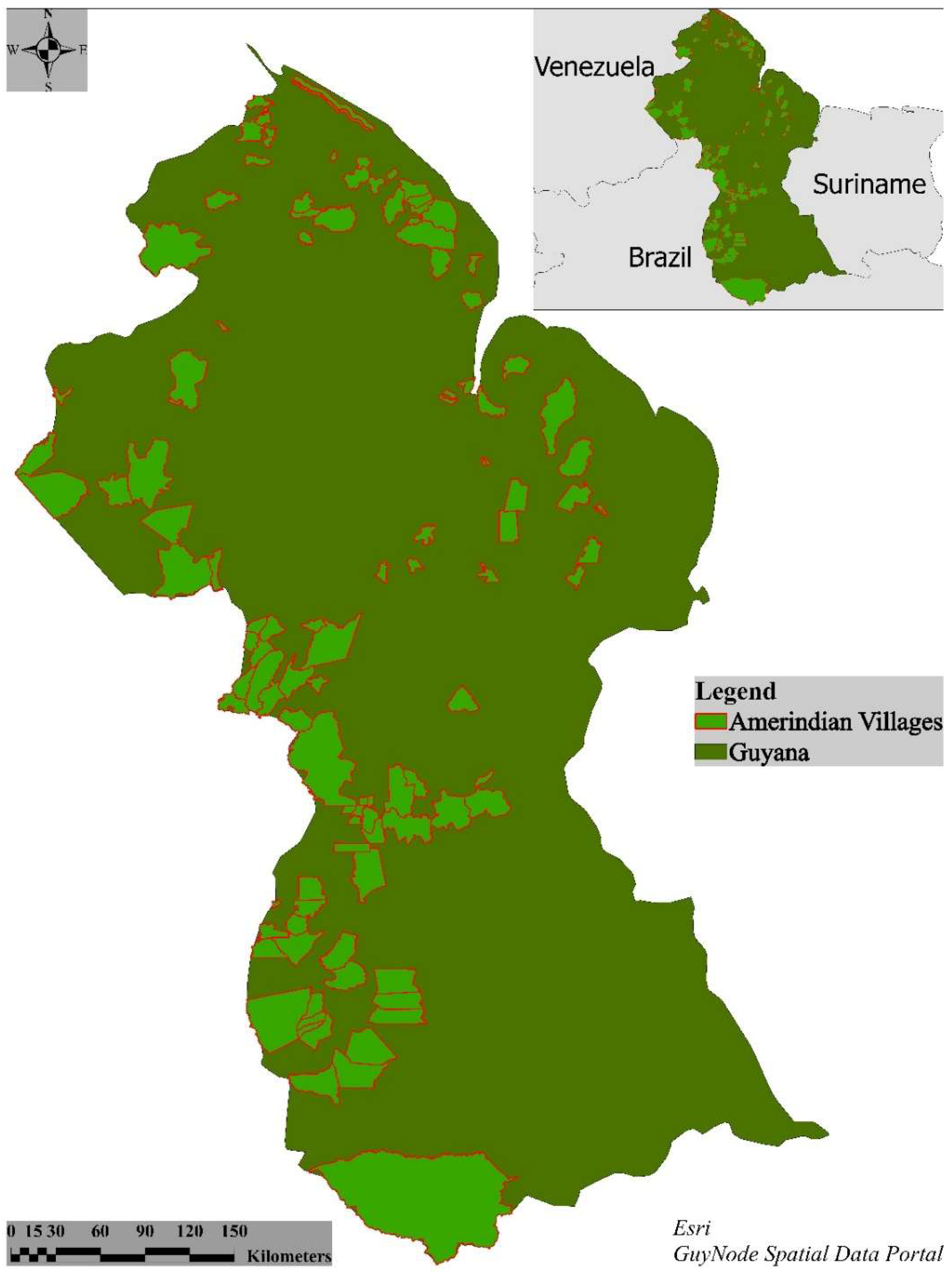

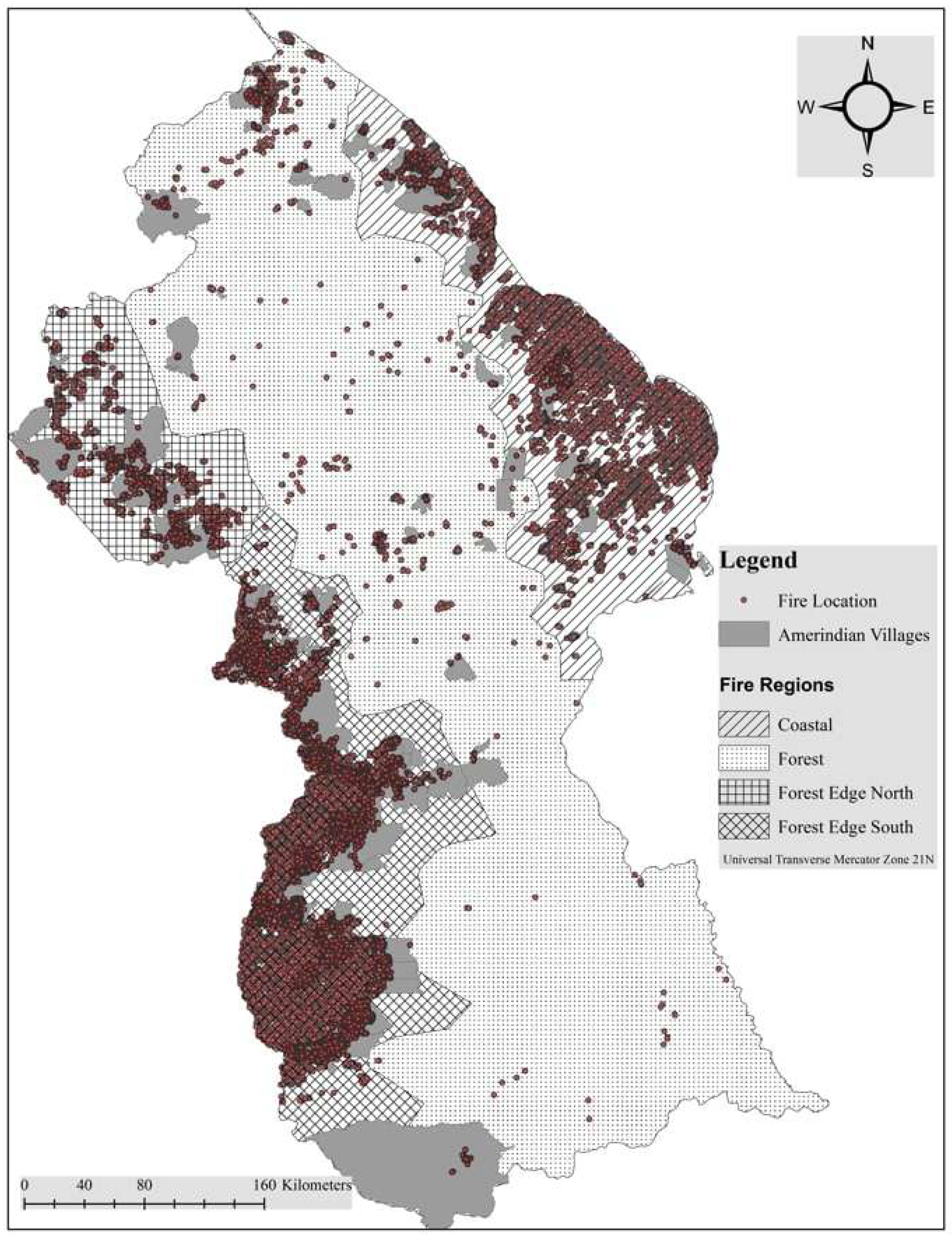
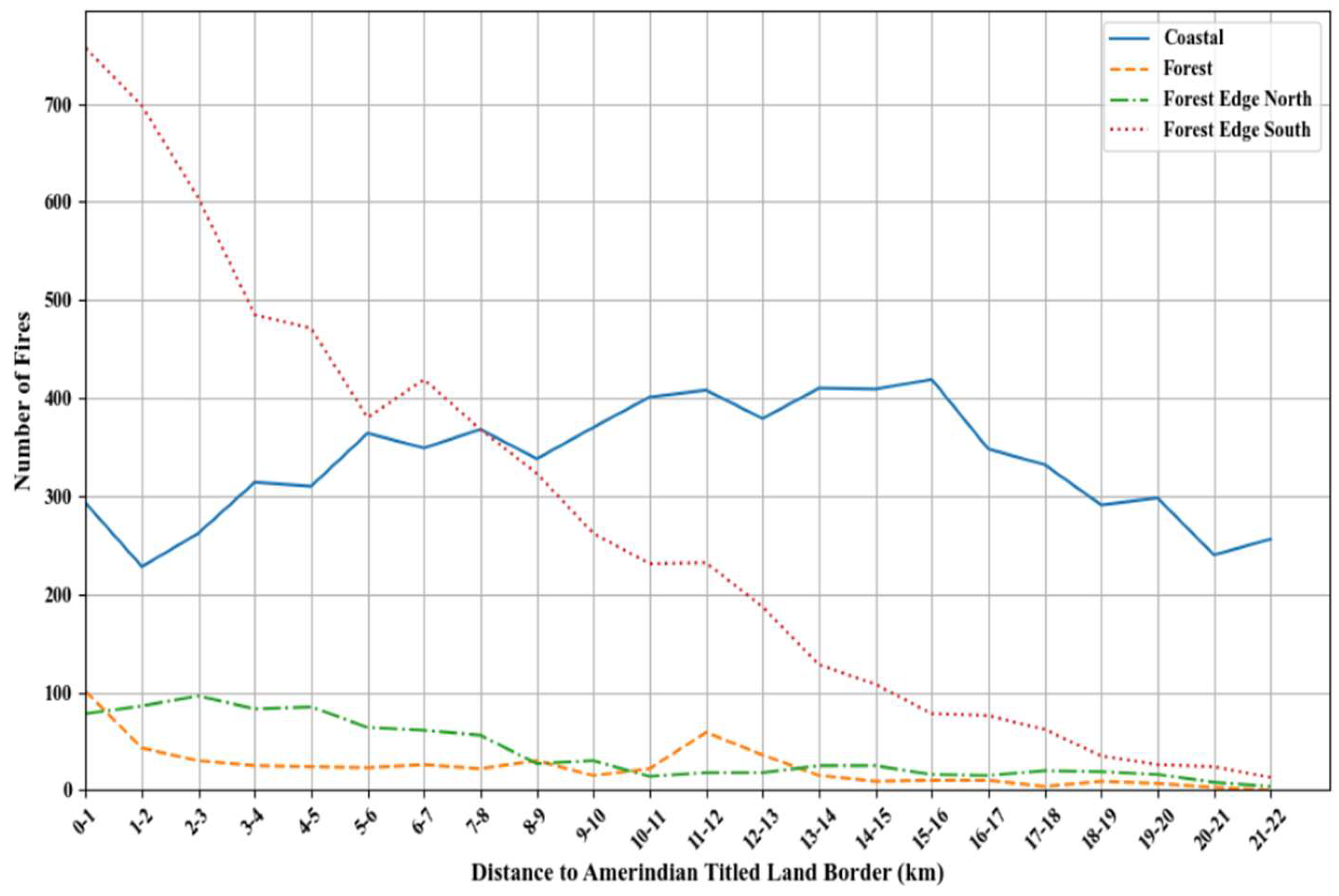
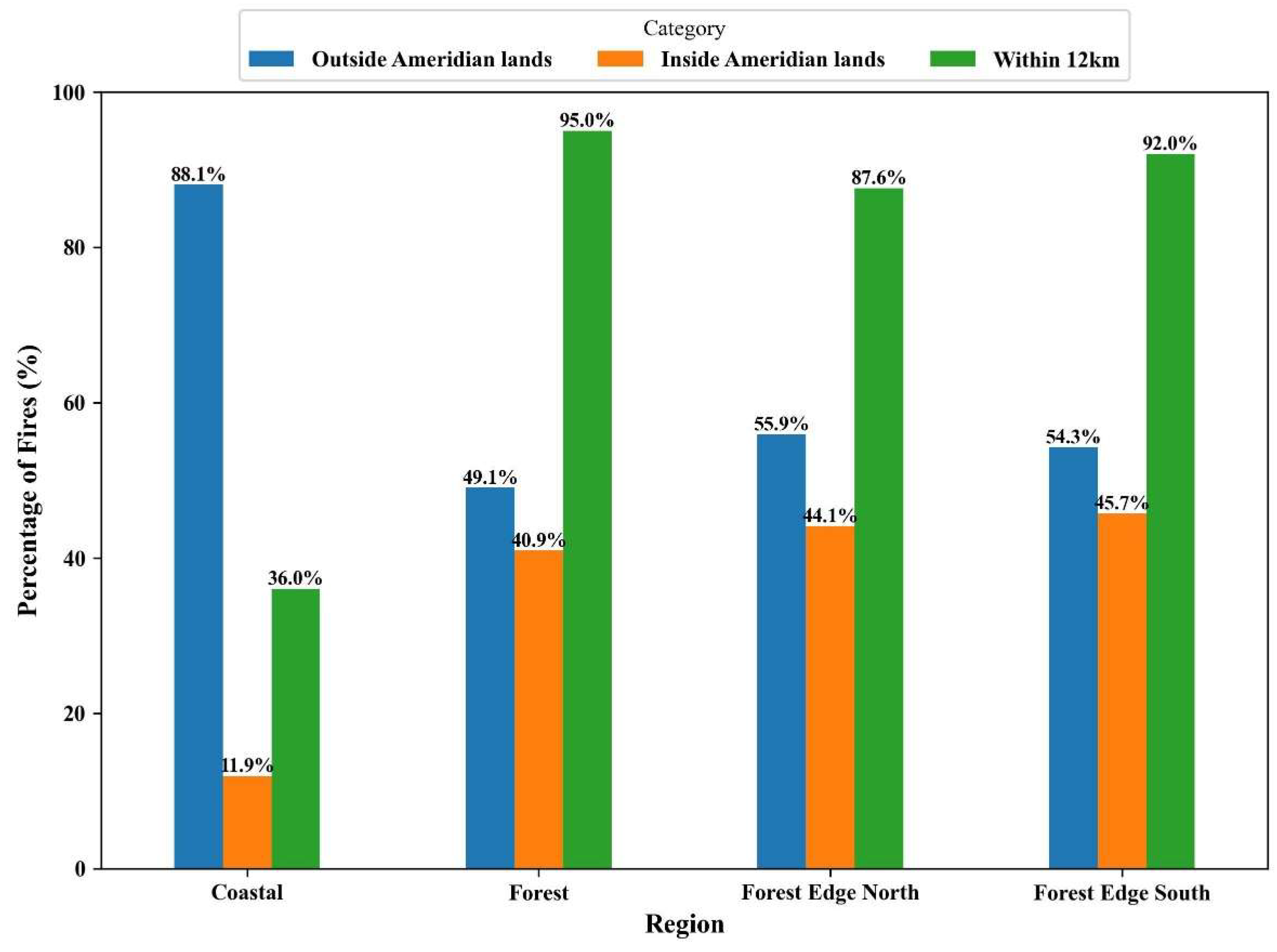
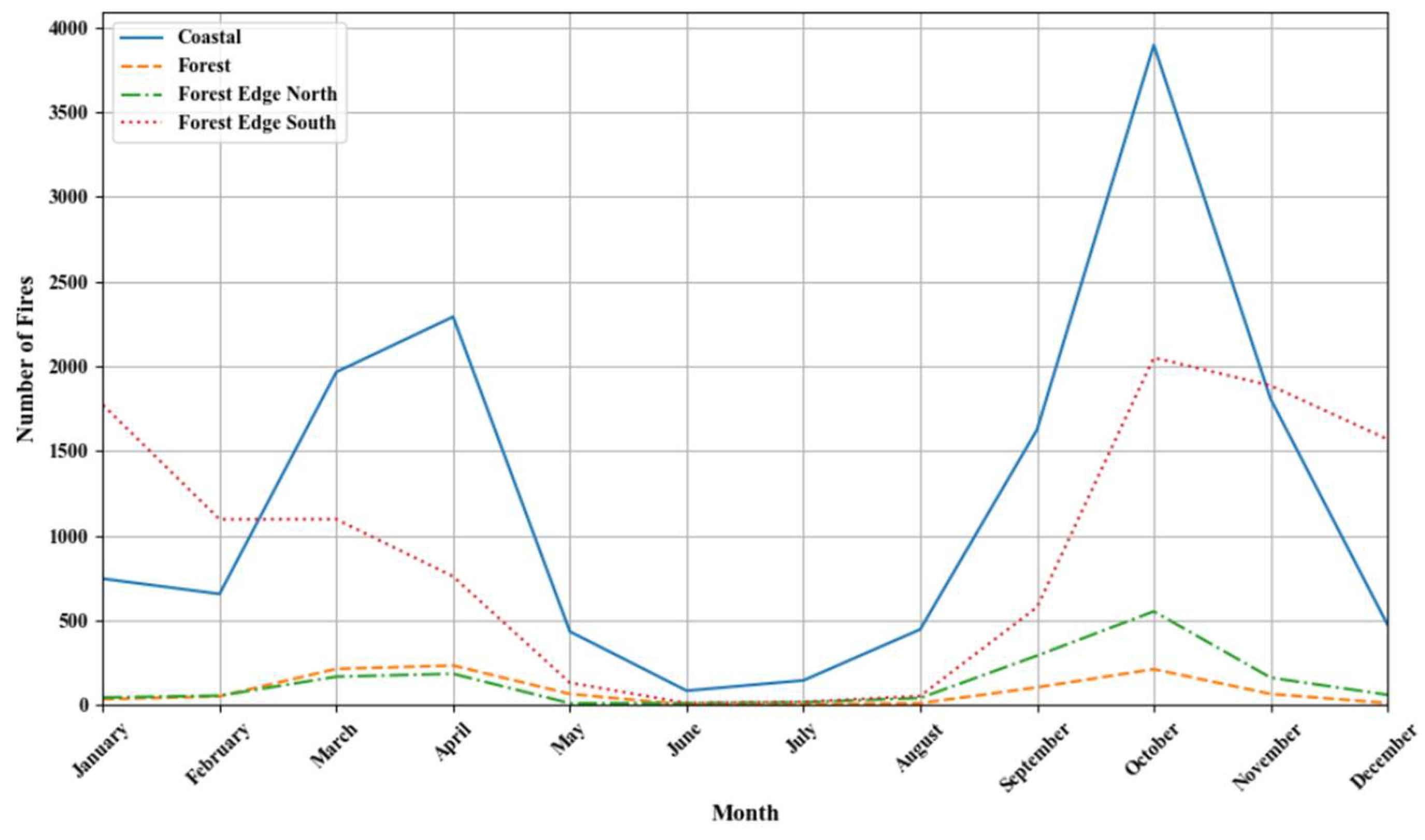
| Year | Number of Fires | Percentage of Total | Intensity of El Niño/La Niña |
|---|---|---|---|
| 2000 | 84 | 0.29 | Weak La Niña |
| 2001 | 966 | 3.39 | Weak La Niña |
| 2002 | 1342 | 4.71 | Moderate El Niño |
| 2003 | 3351 | 11.75 | Moderate El Niño |
| 2004 | 1893 | 6.64 | Weak El Niño |
| 2005 | 1581 | 5.54 | Weak El Niño |
| 2006 | 1541 | 5.40 | Weak El Niño |
| 2007 | 1374 | 4.82 | Weak El Niño |
| 2008 | 1177 | 4.13 | Weak La Niña |
| 2009 | 2141 | 7.51 | Moderate El Niño |
| 2010 | 1775 | 6.22 | Moderate El Niño/Strong La Niña |
| 2011 | 1325 | 4.65 | Moderate La Niña |
| 2012 | 1964 | 6.89 | Moderate La Niña |
| 2013 | 1498 | 5.25 | Absent |
| 2014 | 1876 | 6.58 | Weak El Niño |
| 2015 | 2838 | 9.95 | Very Strong El Niño |
| 2016 | 1796 | 6.30 | Very Strong El Niño |
Disclaimer/Publisher’s Note: The statements, opinions and data contained in all publications are solely those of the individual author(s) and contributor(s) and not of MDPI and/or the editor(s). MDPI and/or the editor(s) disclaim responsibility for any injury to people or property resulting from any ideas, methods, instructions or products referred to in the content. |
© 2025 by the authors. Licensee MDPI, Basel, Switzerland. This article is an open access article distributed under the terms and conditions of the Creative Commons Attribution (CC BY) license (https://creativecommons.org/licenses/by/4.0/).
Share and Cite
Cummings, A.R.; Kennady, B.J.; Adeuga, A.M. Fire Regions of a Northern Amazonian Landscape Relative to Indigenous Peoples’ Lands. Remote Sens. 2025, 17, 3386. https://doi.org/10.3390/rs17193386
Cummings AR, Kennady BJ, Adeuga AM. Fire Regions of a Northern Amazonian Landscape Relative to Indigenous Peoples’ Lands. Remote Sensing. 2025; 17(19):3386. https://doi.org/10.3390/rs17193386
Chicago/Turabian StyleCummings, Anthony R., Benjamin J. Kennady, and Adewole M. Adeuga. 2025. "Fire Regions of a Northern Amazonian Landscape Relative to Indigenous Peoples’ Lands" Remote Sensing 17, no. 19: 3386. https://doi.org/10.3390/rs17193386
APA StyleCummings, A. R., Kennady, B. J., & Adeuga, A. M. (2025). Fire Regions of a Northern Amazonian Landscape Relative to Indigenous Peoples’ Lands. Remote Sensing, 17(19), 3386. https://doi.org/10.3390/rs17193386






